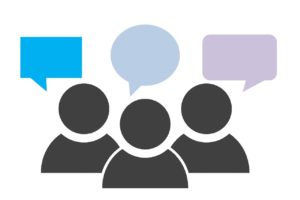Anyone who has followed this blog for a little while has probably noticed the content warnings that appear in some of the book and film reviews I share. I recently realized that I’ve never blogged about what I do and don’t include in my content warnings here, so let’s discuss it.
Please note that I will be briefly discussing things like rape, murder, and violence later in this post to give examples of things I use content warnings for. I will not go into detail on any these subjects, but I always warn my readers in advance when sensitive topics come up. Keep reading at your own discretion.
The Purpose of Content Warnings

The friendliest photo I could find online.
Content warnings are used to alert readers about potentially sensitive material so that they can decide for themselves if they would like to read or watch that content.
Trigger warnings are a specific type of content warnings that are used for subjects that may cause intense psychological symptoms in some cases.
The purpose of these warnings is to give people who have PTSD, anxiety, or other mental illnesses a heads up before suddenly diving into topics that may trigger flashbacks, panic attacks, or other mental health concerns for them.
Since just about anything can be a content or trigger warning for someone out there, it simply isn’t possible to forewarn everyone about anything that might be difficult for them to stumble across in a story or film.
What I Include in My Content Warnings
My goal when writing content warnings for the stuff I review here is to include topics that are widely known to be sensitive or triggering.
I generally warn my readers about the following topics:
- Any form of abuse (sexual, physical, emotional, etc.) against adults, kids, or animals
- Blood and gore
- Descriptive medical procedures (needles, surgery, amputations, etc).
- Violence
- Kidnapping or abductions
- Death or dying (including pets/animals)
- Pregnancy or childbirth (especially if it has a tragic outcome)
- Self-harm or suicide
- Eating disorders
- Sexism, homophobia, racism, transphobia, ableism, classism, etc.
- Mental illness
There have been a few times when readers contacted me privately to ask for clarification for a content warning or to see if something not on this list was included in the book or film I’d reviewed. I’m always happy to answer those questions.
While I do have a spoiler-free review policy in general, I think it’s helpful to let folks know in advance about topics they might need to emotionally prepare for before reading or watching what I recommend here.
How Do You Handle Content Warnings?
 Do you use them? Why or why not?
Do you use them? Why or why not?
If you use them, what topics do you include in them?
Are you open to answering readers’ questions about the content of the stuff you review if they would like to know in advance if something not on your list was mentioned in the book, film, or other piece of media you reviewed?
I can’t wait to hear how all of you handle this topic on your sites and in your reviews.

I like to use ‘Content Warning’ rather than ‘Trigger Warning’ – not because the warning itself is different, but because I think the word ‘trigger’ has gathered some not-good connotations, and people are more likely to pay attention to CWs, because they see it as less of a ‘snowflake’ thing (which is b*llsh** ofc, but I want people to read the warnings.)
I take the attitude that Content Warnings are especially useful for those with mental health issues, but are actually for everyone. Because everyone has mental health, whether it be good, bad, or neutral, and therefore everyone can protect and measure their own ability to deal with content. If you don’t have mental health problems, but your family member has recently died of cancer, for example, you may not want to read a book with cancer as a main theme right now – you might not be ready to ‘go there’ – on the other hand, it might make you *more* likely to read the book, if you feel like you need some understanding, and some external narrative to help you process.
Sometimes I avoid books or fanfiction with warnings for Depression or Anxiety attacks, sometimes I read them anyway, but am thankful I had the warning so I can check in with myself, and sometimes I actively seek out that kind of material.
…This turned into an essay! Woops! 😉 <3
I didn’t realize trigger had accumulated some not-so-good associations with it. Good to know!
And, yes, Content Warnings are definitely good for everyone. 🙂
I don’t use content warnings. In reviewing a book I may comment on gratuitous violence and the like in the review, but I don’t incorporate a separate disclaimer or anything. Although I respect people’s motives in using them for potentially traumatic subjects, I would think a review of the content would offer sufficient warning about it without needing extra warnings up front.
Cool!
I do try to use content warnings in my reviews, though I have been using a smaller list of potential triggers than you have. (I never considered that medical procedures might be a possible trigger, for example.) However, in general I try to go light on the content warnings and put more detail in the review itself—behind a spoiler tag if neccesary.
That’s a good technique, too!
Great topic! It’s an interesting question… especially I am soon to review a book that likely warrants a content warning (Blindness by Saramago). I think it depends how in-depth I describe the content and whether I plan to give specific examples or just allude to it. In the case of Blindness, some of my issues with the book directly relate to the explicit content, so I think it would be courteous to warn people I’m going there…
That makes total sense. I look forward to reading your review!